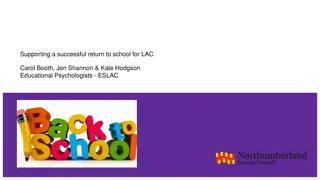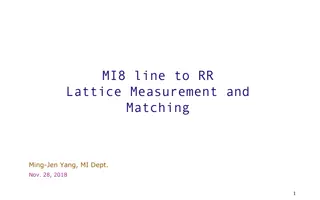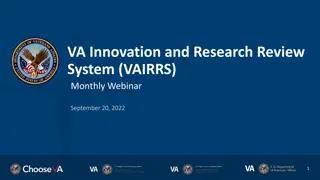
Unlocking Productivity Insights in Northern Ireland
Explore the challenges of sluggish productivity in Northern Ireland, as highlighted in a multidisciplinary study. Discover the complex policy landscape and the need for a systems approach to address interdependent dimensions effectively.
Download Presentation

Please find below an Image/Link to download the presentation.
The content on the website is provided AS IS for your information and personal use only. It may not be sold, licensed, or shared on other websites without obtaining consent from the author. If you encounter any issues during the download, it is possible that the publisher has removed the file from their server.
You are allowed to download the files provided on this website for personal or commercial use, subject to the condition that they are used lawfully. All files are the property of their respective owners.
The content on the website is provided AS IS for your information and personal use only. It may not be sold, licensed, or shared on other websites without obtaining consent from the author.
E N D
Presentation Transcript
Mapping the Cognitive Landscape of Productivity in Northern Ireland: A Systems Approach to Understanding Productivity Policy Jen Nelles (PIN/Sheffield University/CUNY) j.nelles@sheffield.ac.uk @jen_nelles CECAN Webinar, 12 February 2020
Productivity Insights Network Multidisciplinary network funded 2018-2021 by ESRC Aim is to change the tone of the productivity debate in theory and practice Interested in highlighting knowledge gaps, intersections, and interdependencies Forthcoming book: Productivity Perspectives Funds new and ambitious interdisciplinary directions in productivity research across the social sciences that engage partners and deliver impact.
Northern Ireland Also Experiencing Sluggish Productivity Growth Productivity Hours Worked per Week by Region (NUTS 1), 2004-2017 Labour productivity (gross value added per hour worked) by NUTS1 region, unsmoothed, current prices, 2017 200,000,000 Northern Ireland 180,000,000 Wales 160,000,000 East Midlands 140,000,000 Yorkshire and The Humber 120,000,000 West Midlands 100,000,000 North East 80,000,000 South West North West 60,000,000 East of England 40,000,000 Scotland 20,000,000 South East 0 London 2004 2005 2006 2007 2008 2009 2010 2011 2012 2013 2014 2015 2016 2017 0 20 40 60 80 100 120 140 North East North West Yorkshire and The Humber East Midlands West Midlands East of England London South East South West Wales Scotland Northern Ireland UK Average
So what is being done? The policy objectives around productivity have been fairly consistent Policies related to productivity vary as to whether implicitly or explicitly articulated Productivity is a multi-faceted issue with many interdependent dimensions But often broken down into themes/silos that are addressed separately in implementation Maybe this is how we re missing things?
Rationale for a Systems Approach Complexity is a core feature of most policy issues today; their components are interrelated in multiple, hard-to-define ways. Yet governments are ill-equipped to deal with complex problems (OECD 2017, 3). Systems theory offers us a different way to think about and begin to address the productivity puzzle By encouraging us to acknowledge and engage with the complexity of the problem and adopt adaptive strategies
Characteristics of complex systems Characteristic Description A complex system cannot be explained merely by breaking it down into its component parts because those parts are interdependent: elements interact with each other, share information and combine to produce systematic behaviour. INTERDEPENDENCE The behaviour of complex systems is difficult (or impossible) to predict. They exhibit non-linear dynamics produced by feedback loops in which some forms of energy or action are dampened (negative feedback) while others are amplified (positive feedback). Small actions can have large effects and large actions can have small effects. NON-LINEAR DYNAMICS Complex systems are particularly sensitive to initial conditions which produce a long-term momentum or path dependence . PATH DEPENDENCE They exhibit emergence, or behaviour that evolves from the interaction between elements at the local level rather than central direction. This makes the system difficult to control (and focuses our attention on the rules of interaction and the extent to which they are adhered to). EMERGENCE They may contain strange attractors or demonstrate extended regularities of behaviour which are liable to change radically (Geyer and Rihani, 2010; 39; Bovaird, 2008, 320). They may therefore exhibit periods of punctuated equilibria - in which long periods of stability are interrupted by short bursts of change. STRANGE ATTRACTORS The various problems that complexity theory seeks to address - such as predicting climate change, earthquakes, the spread of disease among populations, the processing of DNA within the body, how the brain works, the growth of computer technology and artificial intelligence, and the behaviour of social and political systems - can only be served by interdisciplinary scientific groups (Mitchell, 2009: x). INTERDISCIPLINARY Source: Cairney (2012, 384). Emphasis added.
Types of problems Problem type: Simple Bake a cake Complicated Complex Send a rocket to the moon Raise a child Problem definition Rules Clear Some uncertainty Continuously improved until repeatable Lots of uncertainty No direct transference from context to context Not needed to develop a common understanding; may be helpful Adaptation and continuous learning Same apply every time Expertise Not really required Requires high levels in specific areas Success Follow protocol Experiment to develop protocol Source: Adapted from Finegood (2018)
We treat productivity as a complicated problem when it s really complex complex The 5 foundations of the UK Industrial Strategy The 5 pillars of the Northern Ireland Economy 2030 Industrial Strategy
Systems + Productivity in Northern Ireland Mapping the Cognitive Landscape of Productivity in Northern Ireland: A Systems Approach to Understanding Productivity Policy Adopt a systems approach to: Understand the role of productivity in the economy through the lens of the 2017 Industrial Strategy Explore the factors that affect productivity in Northern Ireland Specifically look for evidence of policy silos and interdependencies that might be being overlooked Find clues to resolving the productivity puzzle.
A Two-Phase Mapping Methodology Document analysis Economy 2030 Industrial Strategy Evidence base (85 documents across 6 themes) Participatory mapping Engage with key stakeholders (i.e. real people)
Hypotheses We were looking for: Evidence of biases by silo but also a presence of conceptual links across pillar/theme/silo boundaries indicating areas for potential joined up and experimental approaches; Unexpected and missing/weak connections between concepts across pillar/theme/silo boundaries or within these groups suggesting areas where further research could add value and models could be modified; Differences between the conceptual relationships identified in the Industrial Strategy versus the broader evidence base, again suggesting potential biases, blind spots, OR important contextual information.
EVIDENCE BASE ECONOMY 2030 INDUSTRIAL STRATEGY 4% 3% 5% 6% 14% 15% 12% Pillar 1 Innovation and Research Pillar 2 Education, Skills, Employability 26% 5% Pillar 3 Inclusive and Sustainable Growth Pillar 4 Global Markets Pillar 5 Infrastructure productivity 38% 12% 60% Distribution of concepts by source
Evidence base Economy 2030 Node size indicates total connections; Line thickness indicates total number of links. Conceptual links between Pillars
Economy 2030 Evidence base Conceptual links
Node 1 skills and talent skills and talent training research transportation infrastructure training training employment, jobs and employability skills and talent skills and talent technology productivity unemployment and inactivity knowledge technology education sustainability employment, jobs and employability education productivity exports employment, jobs and employability skills and talent technology productivity energy training sustainability connectivity exports trade exports infrastructure infrastructure foreign direct investment connectivity infrastructure productivity sustainability trade transportation infrastructure sustainability Node 2 employment, jobs and employability education education innovation infrastructure employment, jobs and employability skills and talent education technology innovation research innovation employment, jobs and employability innovation innovation innovation employment, jobs and employability innovation technology technology innovation technology knowledge knowledge employment, jobs and employability sustainability innovation skills and talent innovation trade innovation skills and talent technology innovation skills and talent technology employment, jobs and employability skills and talent education employment, jobs and employability employment, jobs and employability research Links 1066 497 487 476 463 381 376 346 332 318 302 301 262 234 234 220 188 187 182 175 169 141 129 117 117 106 Node 1 skills and talent skills and talent employment, jobs, and employability exports research international(isation) inclusiveness skills and talent sustainability employment, jobs, and employability inclusiveness trade education inclusiveness productivity international(isation) exports Economy 2030 Node 2 education employment, jobs, and employability education international(isation) innovation innovation employment, jobs, and employability innovation inclusiveness innovation education exports innovation skills and talent innovation education skills and talent Links 35 33 26 26 23 21 19 16 15 12 12 12 10 10 9 9 8 99 98 97 95 93 89 85 77 72 69 69 64 60 60 58 55 Evidence base Most connected pairs
Phase 2: Participatory mapping Column Labels Total Participants academic Plan association firm government Total Plan Row Labels Workshop 1 Workshop 2 Workshop 3 Grand Total Participants Plan Participants Plan Participants Plan Participants 1 1 2 4 0 0 1 1 2 4 2 8 2 2 0 4 2 0 1 3 2 0 1 3 3 6 5 1 6 5 8 5 8 7 11 10 29 14 12 20
Intersections and Synergies Meta Map Economy 2030 Evidence Base Node 1 Entrepreneurship Entrepreneurship Jobs Skills Skills Talent Node 2 Firm growth/scaling New firms Exports Firm growth/scaling Talent Firm growth/scaling Links Node 1 3 Skills and talent 3 Skills and talent 3 Employment and jobs Education 3 Exports 3 Research 3 International(isation) Innovation Node 2 Education Employment and jobs Links Node 1 35 Skills and talent 33 Skills and talent 26 Training 26 Research 23 Transport infrastructure Infrastructure 21 Training Node 2 Employment and jobs Education Education Innovation Links 1066 497 487 476 463 381 International(isation) Innovation Employment and jobs
Summary Productivity policy is visualized in silos but it shouldn t be Applying a systems lens encourages us to look for and be sensitive to policy intersections and interdependencies Cognitive mapping helps identify (and act on?) these potential bottlenecks and opportunities Jobs/Skills > Productivity in these maps might be another explanation for weak outcomes Do we need an actual productivity policy?
Phase 1 findings: Distribution of codes by segment of the evidence base - Education, skills and employability dominates almost every thematic area; - Distribution of codes varies by thematic area; - Infrastructure is an outlier; - Productivity plays a moderate role and varies across evidence base; - These biases will likely show up in relational analysis.





















